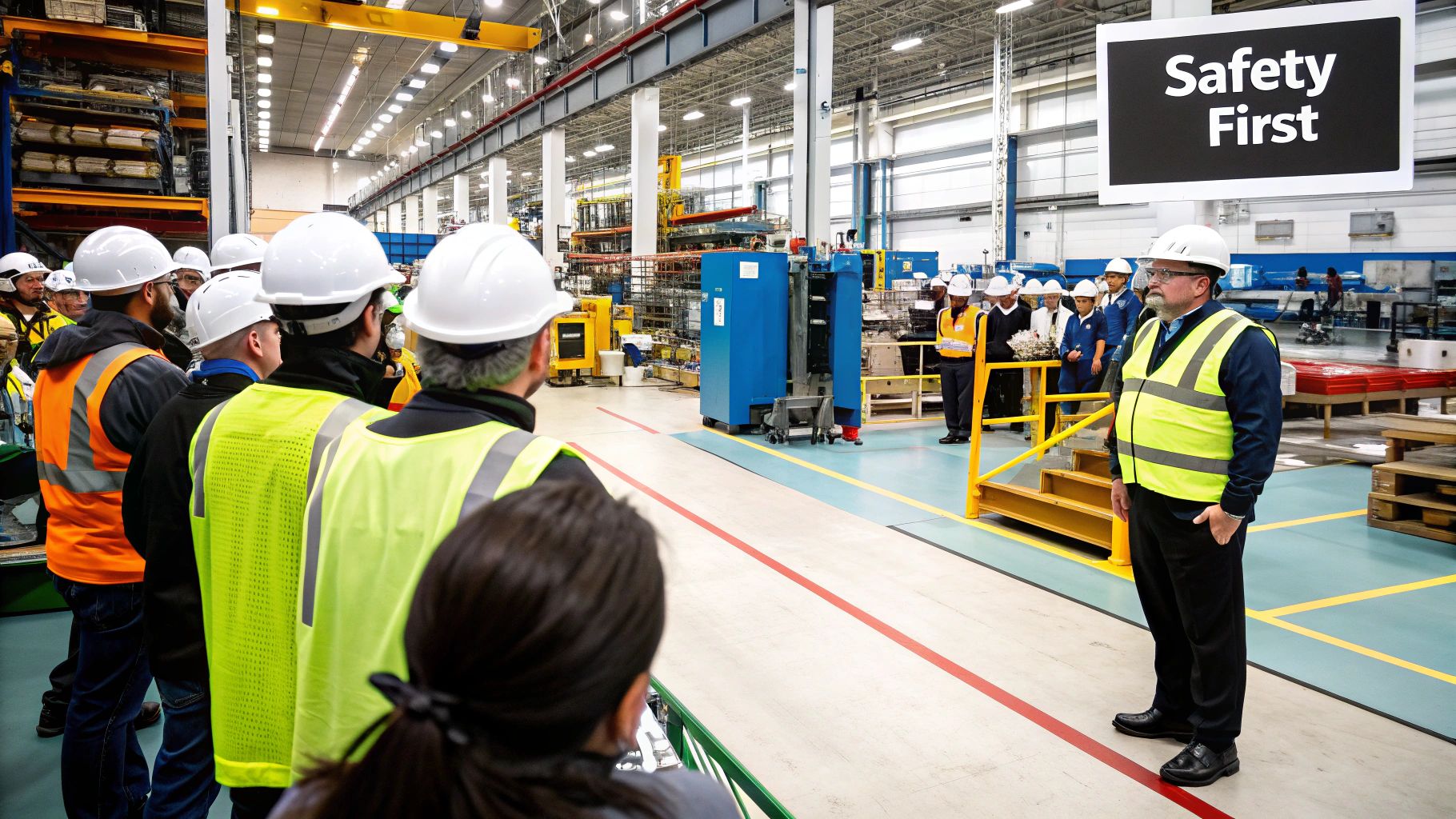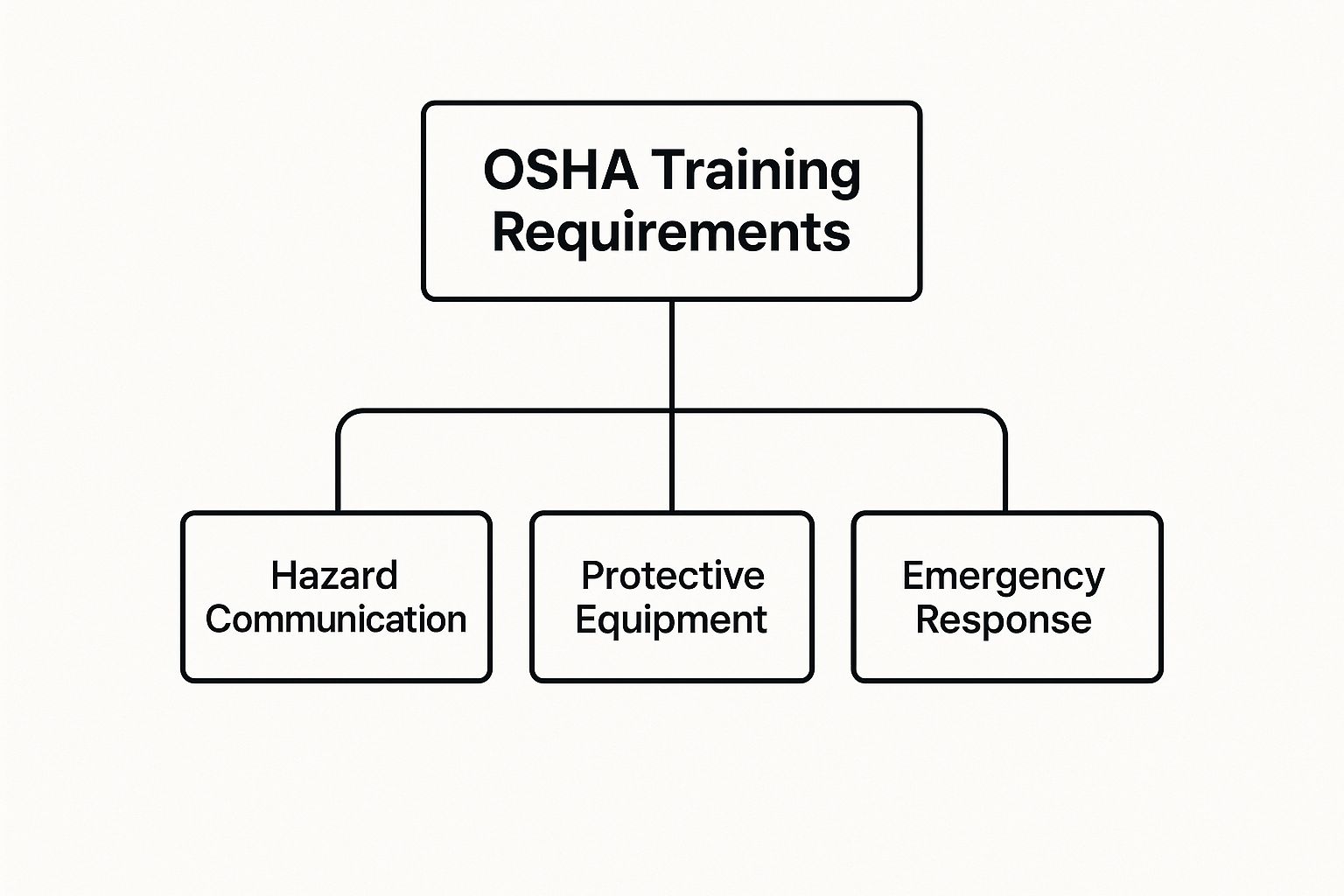OSHA safety training isn't some monolithic, one-size-fits-all rulebook. It's better to think of it as a comprehensive library of standards, each one carefully crafted to tackle specific workplace dangers and ensure every employee knows how to do their job without getting hurt.
Your Guide to OSHA Training Requirements

Here's a good way to look at OSHA's rules: they’re like a driver's education program for your entire business. You wouldn't just hand someone the keys to a forklift without any lessons, would you? Of course not. OSHA applies that exact same logic to every potential hazard on a job site, from handling chemicals to operating heavy machinery.
Getting a solid handle on these requirements is your first real step toward building a genuine culture of safety. The goal isn't just about ticking a compliance box; it's about creating a clear roadmap to prevent accidents, protect your team, and sidestep the massive financial penalties that come with violations. When you get this part right, you’re laying a foundation that strengthens every other safety effort you make.
Why Compliance Is More Than Just Following Rules
The stakes here are incredibly high, both in human terms and on the balance sheet. According to the National Safety Council, the total economic cost of work-related deaths and injuries in 2022 was an eye-watering $167 billion. This figure accounts for everything from lost wages and medical bills to administrative costs and productivity losses.
On top of that, a staggering 108 million workdays were lost that same year due to on-the-job injuries alone. These aren't just abstract statistics; they highlight a critical point: effective safety training is a smart investment, not an expense. It's one of the most direct ways to counter the massive costs of workplace incidents.
For a quick reference, here’s a table that breaks down the core components of OSHA training compliance. It’s a handy cheat sheet for understanding what’s expected.
OSHA Training Requirements At a Glance
This table gives you a snapshot, but it’s important to remember that each of these areas works together to form a cohesive safety program that truly protects your team.
Building a Compliant Safety Program
So, what does putting this all into practice actually look like? At its core, it's a cycle of a few key activities that every employer needs to manage to meet OSHA standards.
This process falls under the broader umbrella of employee compliance training, which is fundamental to running any safe, lawful, and productive business.
Every piece of the puzzle matters. For example, understanding the specific OSHA CPR certification requirements is a critical component for many businesses, ensuring teams are ready to handle medical emergencies. By integrating these specific training modules, you build a resilient safety program that keeps everyone protected.
Navigating General Industry and Construction Standards
One of the first hurdles in tackling OSHA safety training requirements is figuring out which set of rules even applies to your business. It's a critical distinction because the answer shapes your entire compliance roadmap. Get it wrong, and you could end up focusing on the wrong hazards, leaving your team dangerously exposed.
Think of it like this: the General Industry standard is the everyday driver's manual. It covers the fundamental rules of the road for almost everyone, from city sedans to highway vans. The Construction standard, on the other hand, is like a specialized operator's manual for a crane—it has unique, high-stakes rules that just don't apply to regular driving.
General Industry: The Default Standard
For most businesses, the General Industry standards (officially 29 CFR 1910) are the default. If your work doesn't involve construction, agriculture, or maritime operations, you almost certainly fall into this category. It’s a massive umbrella that covers a huge range of workplaces.
This category includes workplaces like:
- Manufacturing plants and warehouses
- Retail stores and restaurants
- Healthcare facilities, from dental offices to clinics
- Office environments and service-based businesses
- Automotive repair shops
Training topics here are often centered on universal hazards. For example, Hazard Communication (HazCom) training is vital for helping employees understand any chemicals they might handle, while training on emergency exit routes and fire extinguisher use is pretty much universal.
The Specialized World of Construction
The Construction standards (29 CFR 1926) are specifically for work involving the building, alteration, or repair of structures. This covers everything from building a new home to massive infrastructure projects. The risks on a construction site are often far more acute and dynamic than in a fixed, general industry setting.
Because of this, the training is intensely focused on the "Fatal Four" construction hazards, which cause the vast majority of deaths in the industry: falls, being struck by an object, electrocution, and getting caught in or between objects. It’s why training in fall protection, scaffolding safety, and electrical safety are non-negotiable pillars of any construction safety program.
Key Takeaway: The single biggest difference isn't just the rules themselves, but the nature of the work environment. General Industry workplaces are typically stable, whereas construction sites are constantly changing, introducing new hazards daily.
The diagram below breaks down some of the foundational pillars—like Hazard Communication, Protective Equipment, and Emergency Response—that apply across different OSHA standards.

This visual shows how these core training areas serve as the backbone for both general and industry-specific safety plans.
Identifying Your Category
To figure out your classification, just ask one simple question: "What is the core function of my business?" If your employees are building a new office park, they fall under Construction. If they will be working inside that completed office park, they fall under General Industry.
It's also crucial to nail down the detailed compliance points within these standards. For instance, no matter your industry, understanding specific guidelines like emergency exit signage requirements is a key part of creating a safe facility. Likewise, knowing the specific OSHA first aid requirements for your site is a critical piece of your emergency action plan.
By correctly identifying your industry category, you can zero in on the exact training topics OSHA mandates for your team. This ensures your efforts are not only compliant but actually effective at preventing harm.
Essential Training Topics for Every Workplace
While every job site has its own unique risks, some safety topics are so fundamental they apply almost everywhere. Think of these as the "greatest hits" of OSHA safety training requirements—the areas that pop up most often in citations and are simply non-negotiable for most employers. Getting these right is the foundation of a genuinely safe and compliant work environment.

We're not just going to list these topics. Instead, we’ll dive into the why behind each rule, showing you how this training translates into real-world protection for your team.
Hazard Communication (HazCom)
The Hazard Communication Standard, or HazCom, is often called the "Right to Understand" rule—an important update from the original "Right to Know." Its goal is simple but powerful: make sure every employee knows about the hazardous chemicals they work with and understands exactly how to protect themselves. This standard is one of the most frequently cited by OSHA, making it a top priority for nearly every business.
Imagine someone grabbing a solvent to clean a piece of equipment, thinking it's harmless. Without proper HazCom training, they wouldn't know it could cause severe skin burns or that the fumes could lead to respiratory damage. A straightforward training session on Safety Data Sheets (SDS), container labels, and handling procedures can prevent a life-altering injury.
Key components of HazCom training include:
- Reading and Understanding Safety Data Sheets (SDS): These are the go-to guides for any chemical's hazards and safety precautions.
- Recognizing Chemical Labels: Employees must know what the pictograms and warnings on chemical containers mean at a glance.
- Using Appropriate Personal Protective Equipment (PPE): This connects the hazard to the solution—knowing when to wear gloves, goggles, or a respirator.
Emergency Action and Fire Prevention Plans
What happens when the fire alarm blares? Is it chaos, or a calm, orderly evacuation? The difference almost always comes down to training. OSHA requires most businesses to have an Emergency Action Plan (EAP) and a Fire Prevention Plan (FPP).
An EAP is the playbook for emergencies like fires, chemical spills, or even natural disasters. It lays out the procedures that turn panic into a practiced response, ensuring everyone knows where to go and what to do.
Crucial Insight: An emergency plan is only as good as its last drill. Regular practice is what makes the procedures second nature, ensuring employees react correctly when it matters most.
Similarly, a Fire Prevention Plan is about stopping a disaster before it starts. This training focuses on identifying potential fire hazards, correctly storing flammable materials, and keeping fire suppression equipment in good working order.
Personal Protective Equipment (PPE)
Personal Protective Equipment is the last line of defense between your employee and a hazard. This training needs to go way beyond just handing someone a hard hat or a pair of safety glasses. Effective PPE training makes sure every employee understands:
- When they need PPE.
- What kind of PPE is right for a specific job.
- How to properly put on, adjust, wear, and take off the equipment.
- The limitations of their gear.
- The proper care, maintenance, and disposal of their PPE.
If you miss any one of these steps, the equipment can be rendered useless. For example, wearing the wrong type of glove for a specific chemical can be just as dangerous as wearing no glove at all.
Medical and First Aid Training
OSHA also mandates that employers ensure prompt medical attention is available if an injury occurs. This often means having employees trained in first aid and CPR, especially if a hospital or clinic isn't in "near proximity" to the workplace.
Beyond the basics, some jobs require more specific knowledge. For instance, employees who might be exposed to infectious materials need dedicated education on the risks and procedures. You can find out more about what this entails in our comprehensive guide to bloodborne pathogens training. This specialized training ensures teams can handle medical emergencies confidently and safely, protecting both the person who is hurt and the person helping them.
Why Global Safety Standards Mirror OSHA Principles
Even though OSHA is a United States agency, its influence stretches far beyond American borders. Think of it as the original blueprint for workplace safety. The framework it created for protecting workers has become a gold standard that other countries often look to when building their own safety programs.
This isn't just a vague idea—the numbers back it up. North America, with its strong regulatory environment led by the U.S., is the powerhouse of the global safety training industry. In 2023 alone, the OSHA Safety Training market in this region was valued at a massive $1.8 billion. And it's not slowing down; projections show it climbing to nearly $3.3 billion by 2032. You can dig into the numbers yourself in the OSHA safety training market research at Dataintelo.com to see just how significant this growth is.
A Common Language of Safety
OSHA's influence has created a ripple effect worldwide. From Europe’s own European Agency for Safety and Health at Work (EU-OSHA) to the rapidly growing industrial centers in Asia and South America, the core principles are becoming universal.
Key concepts are now a shared language in workplace safety:
- Identifying potential hazards
- Properly training employees
- Providing the right protective gear
- Having a solid plan for emergencies
This global alignment sends a clear message: a strong safety culture isn't just about ticking a box for local compliance. It’s a recognized sign of quality, responsibility, and reliability on an international stage.
For any business operating globally or planning to expand, this trend is impossible to ignore. Meeting high safety standards is no longer just about following rules in one country. It’s about speaking a global language of safety that partners, clients, and employees everywhere have come to expect.
The Value of a Universal Approach
The convergence of safety philosophies really boils down to one simple truth: the things that prevent accidents are the same everywhere. A fall hazard on a construction site in Ohio is just as deadly as one in Germany, and the training needed to prevent it is fundamentally the same.
Global Business Imperative: Investing in a robust safety program based on proven principles isn't just a U.S. requirement; it's a strategic move that enhances a company's reputation and operational integrity on the world stage.
This standardization puts companies that already follow OSHA safety training requirements in a great position. They’re building a safety-first culture that not only protects their team at home but also aligns perfectly with the rising expectations of the global marketplace.
Ultimately, it’s about creating a workplace where safety is a core value, understood and respected no matter where you do business. Taking this proactive approach ensures you're ready for today's regulations and whatever global standards come next.
Mastering Your Training Recordkeeping
Training your team is half the battle; proving you did it is the other half. When it comes to OSHA safety training requirements, your documentation is your first and last line of defense. There's a simple, unforgiving principle that every safety pro lives by: if it’s not documented, it didn’t happen.
This section is all about creating bulletproof records—the kind that leave no room for doubt during an audit. Getting your paperwork in order isn't just about ticking a box for compliance; it's about building a clear, unshakeable history of your commitment to a safe workplace.
The Anatomy of a Perfect Training Record
So, what does an OSHA inspector really want to see? A compliant training record is much more than a simple sign-in sheet. It’s a detailed snapshot that proves not only that training occurred, but that it was meaningful, specific, and delivered by someone qualified.
Each record, whether you keep it digitally or in a physical binder, needs to answer a few key questions. Think of it as telling the complete story of each training session so there are no gaps for an inspector to question.
Inspector’s Principle: "If it’s not documented, it didn’t happen." Let this phrase guide your entire recordkeeping strategy. A verbal confirmation or a vague note on a calendar just won't cut it under scrutiny. You need concrete, detailed proof.
To stay compliant, you need an organized system that’s easy to pull up and review at a moment's notice. Whether you use dedicated software or a meticulously organized binder, consistency is everything.
What Every Training Record Must Include
For every single training you conduct—from a quick toolbox talk to an all-day certification course—your documentation must capture the essential details. Missing even one piece of information can create a hole in your compliance armor.
Here's a look at the non-negotiable data points you need to collect for every employee.
Essential Elements of a Training Record
Use this checklist to ensure every employee safety training record contains the information OSHA requires for full compliance.
Having these four pillars in place for every record is fundamental. It creates a clear, auditable trail that shows exactly who was trained, on what, when it happened, and who provided the instruction.
Record Retention: How Long Is Long Enough?
One of the most common questions we get is how long to hang onto all this paperwork. Unfortunately, OSHA doesn't have a single, universal retention period. The timeline depends entirely on the specific standard you're dealing with.
- Some records, like those for Bloodborne Pathogens exposure incidents, must be kept for the duration of employment plus 30 years.
- Training records for specific standards, like Lockout/Tagout, must be kept until they are replaced by new training records.
- For many general topics, a good rule of thumb is to keep records for at least 3 to 5 years, but you should always double-check the requirement for each specific standard.
When in doubt, it’s always better to hold onto a record longer than you think you need to. For topics that involve significant risk, like emergency response, maintaining a thorough history is critical. For instance, our guide on Stop the Bleed training highlights the importance of keeping skills sharp for life-threatening situations, and your records should reflect that ongoing readiness.
Choosing Your Ideal Safety Training Partner

With the high demand for workplace safety education, picking the right provider for your OSHA safety training requirements can feel like finding a needle in a haystack. The market is full of options, but they aren't all created equal. Your goal is to find a partner who delivers real-world skills and lasting value—not just a certificate to check a box.
This decision is more than just about compliance. It’s a direct investment in your company's future. The right partner helps you build a genuine safety culture that protects your team and strengthens your business from the inside out.
Vetting Your Training Options
When you start looking at potential providers, you need to look past the slick marketing and dig into the substance of their programs. The best training partners are completely transparent about their credentials and teaching methods, making it easy to see the quality you're paying for.
Start by asking a few key questions:
- Are the instructors certified? Look for trainers accredited by nationally recognized organizations like the American Red Cross or the American Heart Association. This is your assurance that the training is based on current, accepted standards.
- Is the training hands-on? Let's be honest—watching a video isn't the same as practicing a skill. Effective training, especially for topics like first aid, requires active, hands-on participation to build the muscle memory and confidence your team needs.
- Can they customize the program? A one-size-fits-all approach is rarely effective. A great partner will work with you to tailor the training to address the specific hazards your employees encounter every day.
Choosing a training provider is like choosing a long-term business partner. Their expertise (or lack thereof) will directly impact your company’s safety, compliance, and overall resilience.
This focus on quality is reflected in the market's growth. The OSHA safety training market was valued at about $1.92 billion in 2021 and is projected to grow, driven by industrial expansion and stricter safety enforcement. You can discover insights into the safety training market at datainsightsmarket.com to learn more.
Why Quality Training Is a Strategic Investment
Investing in a high-quality partner like Ready Response pays off in ways that go far beyond just meeting compliance standards. When training is engaging and relevant, your employees don't just memorize rules—they adopt a true safety mindset. They become more aware of their surroundings and get much better at spotting and handling risks before an accident can happen.
This proactive approach is critical, especially when it comes to life-or-death skills. For a closer look at why this type of preparation is so vital, you can explore our article on the need for CPR training in the workplace.
Ultimately, picking an expert training partner is one of the most important steps you can take to create a workplace where everyone goes home safe at the end of the day.
Your Top OSHA Training Questions, Answered
When you're trying to keep your team safe and compliant, the world of OSHA safety training requirements can feel like a maze. It’s natural to have questions about the specifics. Let's clear up some of the most common ones we hear from employers and employees. Getting these details right is the key to running your safety program with confidence.
How Often Do My Employees Need Refresher Training?
This is a great question, but the answer isn't a simple one. There’s no single, universal schedule for OSHA refresher training. The right timeline depends entirely on the specific OSHA standard that applies to the hazard your team faces.
Some standards are very direct with their timelines. For example:
- Annual Training: Things like fire extinguisher training often need a yearly refresher to keep those skills sharp and ready.
- Periodic Re-evaluation: Forklift operators, on the other hand, must be re-evaluated every three years to confirm they're still operating their equipment safely.
For many other hazards, retraining isn't based on a calendar but is triggered by specific events. You'll need to provide more training if a new hazard pops up, an employee's job changes, or if you notice someone isn't quite remembering what they learned the first time. The golden rule? Always check the specific standard to be sure.
Does Training Have To Be In English?
Not at all. OSHA is very firm on this: training must be delivered in a language and vocabulary that workers can understand. If you have team members who speak Spanish, Polish, or any other language, you are legally obligated to provide the training in that language.
Key Compliance Point: The whole point of training is for people to understand it. Just having a non-English-speaking employee sit through a class in English doesn't count. For the training to be effective and meet OSHA's rules, your team has to truly grasp the material.
This ensures every single employee, no matter their native language, gets the knowledge they need to stay safe on the job. It's about genuine understanding, not just checking a compliance box.
What Is the Difference Between OSHA 10 and OSHA 30 Cards?
The OSHA 10-Hour and 30-Hour cards are part of OSHA's voluntary Outreach Training Program. Think of them as foundational safety courses that, while not directly required by OSHA for every single job, have become a huge industry standard, especially in construction.
The main difference comes down to who they're for and how deep they go:
- OSHA 10-Hour Card: This is the entry-level course built for frontline workers. It gives them a solid, basic awareness of common job site hazards, plus a foundational understanding of their rights and how to work safely.
- OSHA 30-Hour Card: This is the more advanced program designed for supervisors, managers, and anyone with safety oversight. It dives deeper into a wider range of topics, focusing on how to spot, prevent, and manage workplace hazards.
While OSHA itself doesn't mandate these cards for everyone, many states, cities, and private employers do. They've become a trusted benchmark for proving a person has a baseline level of safety knowledge.
At Ready Response, we know that great safety training is about more than just meeting rules—it’s about giving your team the skills and confidence to act when it counts. From hands-on CPR and first aid to specialized safety courses, we provide expert, accredited training made for the real world. Visit https://readyresponsepa.com to see how we can help you build a safer, more prepared workplace.
